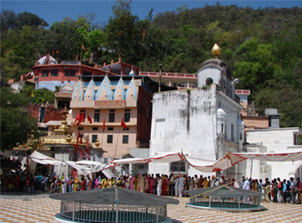 Location: 34-km South Of Kangra Location: 34-km South Of Kangra
Altitude: 1,737m
Houses: Jwalamukhi Devi Temple
Main Attraction: March-April & September-October
Navaratra Celebrations
Famous As A: Hindu Pilgrimage
The Flaming Goddess
Jwalamukhi is 34-km from Kangra and 56 km from Dharamsala.
Recognised as one of the 51 Shaktipiths of India, Jwalamukhi's
Devi Temple, tended by the followers of Goraknath, is
set against a cliff. The picturesque temple, built against
a wooded spur, in the Indo-Sikh style, has a dome that
was gilded by Mughal Emperor Akbar.
An eternally burning flame that issues from a hollow rock
in the sanctum is considered the manifestation of the
goddess Devi. During March-April and September-October
every year colourful fairs are held during the Navaratra
celebrations.
THE LEGEND OF JWALAMUKHI
Jwalamukhi is a famous temple of goddess Jwalamukhi, the
deity of flaming mouth, built over some natural jets of
combustible gas, believed to be the manifestation of the
Goddess. The building is modern with a gilt dome and pinnacles,
and possesses a beautiful folding door of silver plates.
Under the gaze of the Dhauladhar range and set amidst
the undulating hills that character sub-Himalayan Himachal
Sati's tongue is believed to have fallen at Jwalamukhi
and the goddess is manifest as tiny flames that burn a
flawless blue through fissures in the age old rock.
Raja Bhumi Chand Katoch of Kangra, a great devotee of
goddess Durga, dreamt of the sacred place and the Raja
set people to find out the whereabouts of the site. The
site was traced and the Raja built a temple. The burning
flames and the complex have come to be known as Jwalamukhi.
The temple located on a small spur on the Dharamsala-Shimla
road at a distance of about 20-kms from the Jwalamukhi
Road Railway Station attracts lakhs of pilgrims every
year. No idol is located in the temple but only the flames,
which come out from the crevices of the rock, are worshipped.
They are natural jets of combustible gas.
There is a small platform in front of the temple and a(check
usage) big mandap where a huge brass bell presented by
the King of Nepal is hung. Usually milk and water are
offered and the ahutis or oblations are offered to the
sacred flames in the pit, situated in the centre of the
temple in between the floor pillars supporting the roof.
The deity is- offered Bhog of Rabri or thickened milk,
Misri or candy, seasonal fruits, milk and arti is done.
There is a mystic Yantar or diagram of the goddess, which
is covered with, shawls, ornaments and mantras are recited.
The puja has different 'phases' and goes on practically
the whole day. Arti is done five times in the day, Havan
is performed once daily and portions of "Durga Saptasati"
are recited.
Maharaja Ranjit Singh paid a visit to the temple in 1815
and the dome of the temple was gold-plated by him. Just
a few feet above the Jwalamukhi temple there is a six-feet
deep pit with a circumference of about three-feet. At
the bottom of this pit there is another small pit about
one and a half feet deep with hot water bubbling all the
time.
|
|
|
|
Temple Officer Jawala Ji
01970-222223 |
|
Open |
Close |
| |
Winter |
Winter
|
| |
07:00 Am to 11:30 Am |
11:30 Am to 12:30 Pm |
| |
12:30 Pm to 09:30 Pm |
|
| |
Summer |
Summer |
| |
06:00 Am to 11:30 Am |
11:30 Am to 12:30 Pm |
| |
12:30 Pm to 10:00 Pm |
|
| |
|
|
Aarti Timing |
| |
Winter |
Summer |
| |
07:00 Am
07:00 Pm |
06:00 Am
08:00 Pm |
| |
|
|
|